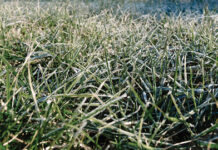Aside from trying to thicken-up a lawn, are there other reasons for doing a Spring overseeding? One big reason for overseeding is to adjust the cultivar, or add multiple species to an old lawn. As time goes by, some older turfgrass species have shown they are more susceptible to certain insects or fungus. With the constant advancements in hybrid turfgrasses, there are considerably more options today that can make a major impact in combating a multitude of common lawn diseases. When choosing a seed, this is something that can—and should—be researched based on diseases in your growing zone.

Another reason to offer a Spring overseeding treatment is for color enhancement. Again, new seed varieties are being released every year and many of them are focusing on darker color and even slower growth rates. Slowly introducing new cultivars into the turf can create a beautiful new-looking lawn that will have your customers thanking you repeatedly. These new turf types will ultimately lower the maintenance needs and provide an even more enjoyable landscape.
Germination
Is there anything that you can do to ensure a better result? Yes, but Mother Nature will be the biggest challenge. Too much or not enough rain, too much or not enough heat, too much or not enough cold… All of these things can hinder the seed from developing into mature grass. Let’s start with the basics and just say “fertility is vital.” I feel like this is somewhat of an understatement. Not only is getting your fertilizer correct a necessity, it may actually be the most important decision to be made. While a seed can germinate without fertilizer, ensuring that it has access to nutrients as the roots push into the soil will create a safety net to help keep the grass alive if environmental factors like drought, frost, or even traffic come into play.
Fertility is indeed vital, but never forget that it’s Mother Nature’s game and she doesn’t always play fairly. What happens if you don’t get enough water to your fertilizer? It doesn’t have much of a chance of doing anything until water is in regular supply. What if the fertilizer gets wet and temperatures begin to increase? You can have losses that will not benefit the seed or even present a detriment to the emerging grass blades. What happens if it’s too cold? Well, at least it will stay present unless some sort of deluge washes it away. The same things that can negatively affect the germination of the seed can also affect the efficacy of the fertilizer being applied with it.
It’s with these factors in mind that many people turn towards humic acid based soil amendments and biostimulants —or choose liquid fertilizers over granular to ensure they get a better result. Recent germination studies have shown some very promising and exciting results in the world of humic and fulvic acids with increased germination rates, deeper and stronger roots, and even greater fertilizer efficiency. Adding these substances to your fertilizer at the time of seeding will give your lawns the best chance to beat Mother Nature’s sometimes ill behavior.
Fertilizer
What’s the best fertilizer to be applied? As mentioned above, there is always a question about what might be a better option: liquid or granular? Personally, I don’t think it matters too much. It mainly comes down to what is easiest to be applied at the time. The most important piece is getting the correct amount of nutrients out and being sure that all of the grass benefits from it. Typically, applying fertilizer that has a nitrogen to phosphorus rate of 1 to 1 or 1 to 1.5 is going to be the best option. The exception to this rule would be if the soils are high in phosphorus already. While some may know this information about their soil already, the only other way to determine it would be to soil test prior to application. However, this is undoubtedly tricky when you are trying to get things done in the Spring. You know you have to finish work quickly and get these lawns into a regularly scheduled fertility program. This is when using a typical 1:1 ratio fertilizer comes in handy and will pretty much never fail.
Typical seed recommendations will have you putting out one pound per thousand of each nutrient and this will also benefit the existing turfgrass all around. This will act as your first major feeding of the season and will get all of the turf through to its next scheduled fertilization.
Preparation
Let’s talk about the preparation. Is it necessary to aerate before your Spring overseeding? No, it is not. Does it hurt to do it? Also no. Again, it’s true that overseeding doesn’t require any mechanical intervention. This is purely optional application because, as stated before, there is already an existing stand of grass that will be shading and protecting the seed. There are three steps I have always followed in any early over-seeding projects: mow the lawn short; clean up any debris that could potentially interfere with the seed getting close to the soil; and water. Just doing that will get the environment ready for grass to grow.
But what about pre-emergent? This is definitely a concern if you are in an area that deals with crabgrass or other invasive weeds that can outcompete your turf. There are chemicals that can be applied, such as Mesotrione, that can help prevent crabgrass emergence long enough for you to be able to come back over the lawn (when new seed has established) with a later application of pre-emergent. In this case, Dithiopyr would be a great follow up as its active ingredient can catch post emergent young crabgrass.
So is Spring overseeding worth it? In my opinion, yes. There will always be a risk it won’t work out the way it’s supposed to. With seeding there are no guarantees. Make sure your customers under-stand this, and that you, as a turfgrass pro, have explained all the potential outcomes that come along with this type of service. At the end of the day everybody just wants the most beautiful lawn on the block. You have the tools to make this happen!
 Perry is President/CEO Founder of Greene County Fertilizer Company and author of Lawncology®. Greene County Fertilizer Company, based in Greensboro, GA, is a manufacturer and supplier of soil amending fertilizers for liquid lawn, garden, turf care and agricultural products, specialty fertility products, humic acid, private label fertilizer products, and custom blend programs.
Perry is President/CEO Founder of Greene County Fertilizer Company and author of Lawncology®. Greene County Fertilizer Company, based in Greensboro, GA, is a manufacturer and supplier of soil amending fertilizers for liquid lawn, garden, turf care and agricultural products, specialty fertility products, humic acid, private label fertilizer products, and custom blend programs.
Originally published in April 2022.
Read more:
“Turf Care: Amazing Mycorrhizae”











![[VIDEO] Dickies®: Discover Workwear That’s Anything But Uniform](https://turfmagazine.com/wp-content/uploads/2023/06/1647663814-4b1a2a7742790a9b1e97a3b963477850192e1d6a9dfba9b07214a77bae25d6e3-d-218x150.jpg)




























![[VIDEO] Dickies®: Discover Workwear That’s Anything But Uniform](https://turfmagazine.com/wp-content/uploads/2023/06/1647663814-4b1a2a7742790a9b1e97a3b963477850192e1d6a9dfba9b07214a77bae25d6e3-d-324x160.jpg)